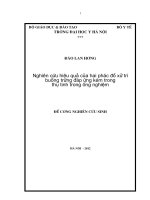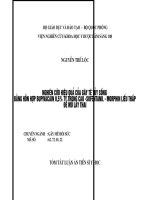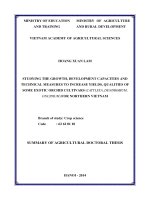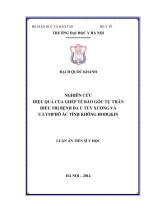nghiên cứu hiệu quả của gây tê tủy sống bằng hỗn hợp bupivacain 0,5% tỷ trọng cao - sufentanil - morphin liều thấp để mổ lấy thai bản tóm tắt tiếng anh
Bạn đang xem bản rút gọn của tài liệu. Xem và tải ngay bản đầy đủ của tài liệu tại đây (196.96 KB, 37 trang )
MINISTRY OF EDUCATION AND TRAINNING - MINISTRY OF DEFENCE
108 INSTITUTE OF CLINICAL MEDICAL AND PHARMACEUTICAL SCIENCE
NGUYEN THE LOC
EFFECTIVENESS RESEARCH SPINAL ANESTHESIA
WITH A MIXTURE OF 0,5% BUPIVACAINE HIGH DENSITY -SUFENTANIL – LOW DOSE
MORPHINE FOR CESAREAN
Specialty: Anesthesiology
Code: 62. 72. 01. 22
SUMMARY OF DOCTORAL THESIS MEDICINE
Hanoi – 2013
THE THESIS WAS DONE IN: 108 INSTITUTE OF CLINICAL MEDICAL AND PHARMACEUTICAL
SCIENCE
Scientific instructors:
1. Ass Prof. PhD. Phan Dinh Ky
2. Ass Prof. PhD. Cong Quyet Thang
Objection 1:
Objection 2:
Objection 3:
This thesis will be presented at Institute Council at:
Day Month Year
The thesis can be found at:
1. National library
2. Library of 108 Institute of clinical medical pharmacological science
1
BACKGROUND
Anesthesia, obstetric anesthesia, especially in caesarean section are more complicated because
most cases of cesarean section was emergency surgery, preoperative preparation is not entirely as
desired, required posed for anesthesia are: Ensuring safety for mother; ensure safety for the
developing fetus and child after birth; maximum advantage for the surgeon conducting the
operation .
We're doing this study is titled "Study of effective spinal anesthesia with 0.5 % bupivacaine
mixture of high density - sufentanil - low-dose morphine for caesarean section", in order to achieve
two objectives:
1. Comparison of effects of spinal anesthesia in surgery and pain after cesarean delivery of
0.5 % bupivacaine 7.5 mg high proportion - 100mcg combined with morphine or fentanyl 20mcg
sufentanil 2mcg.
2. Rating undesirable effects on mothers and fetuses when spinal anesthesia using the
aforementioned drugs.
NEW CONTRIBUTION OF THE THESIS
- The theme suitable for specialized obstetric anesthesia.
2
- This topic has significant scientific and practical, applicable in many maternity hospitals.
- Coordinate with sufentanil bupivacaine in spinal anesthesia for cesarean section is applied in
Vietnam, combined with low-dose morphine 100mcg helps reduce postoperative pain lasted another
24 hours, very beneficial for women after surgery tongue.
- Comparison of the two study groups for better pain outcomes in the study group. Analgesic
effect fast and strong, few side effects.
- No effect on the fetus.
The structure of the thesis:
131 page thesis, apart from the question, conclusions and recommendations thesis consists of
four chapters: chapter 1 overview page 39, chapter 2 subjects and research methods page 20,
chapter 3 study results 35 chapter 4 discusses the page and page 31.
Thesis has 40 tables, 14 charts, 9 photos and 139 references (document 44 Vietnamese, 77
English documents and 18 documents in French).
3
4
Chapter 1
OVERVIEW
1.1. Some characteristics of anatomy, physiology of pregnant women related to anesthesia
Pregnancy as the mother's body changes important to adapt to new physiological conditions to
ensure good for both mother and fetus.
1.1.1 . The spine , the spinal cavity and
1.1.2 . Changes in respiratory
1.1.3 . Changes in the circulatory system
1.1.4 . Changes in the digestive system
1.2 . A brief history of spinal anesthesia for caesarean section
1.3 . Regional anesthesia for caesarean section
1.4 . Physiology of pain
1.4.1 . Definition of pain
According to the International Association for Research on Pain (IASP - International
Association for the Study of Pain) definition: pain is an unpleasant situation in terms of feelings
and emotions are caused by tissue damage existence (real or potential in the model depends on the
cause and severity of her injuries).
1.5. The drugs used in spinal anesthesia for cesarean
1.5.1. Pharmacology anesthetic bupivacaine:
5
1.5.2. Sufentanil pharmacological drugs.
1.5.2.1. Pharmacokinetics
- Sufentanil is fat soluble so similar pharmacokinetics of fentanyl .
- Do sufentanil have a higher degree of ionization at physiological pH and level of protein
binding in plasma is higher, so it has a smaller volume of distribution and half-life shorter than
fentanyl .
1.5.3 . Pharmacology Fentanyl drug
1.5.4. Morphine pharmacological drugs (type no preservatives
- Opiphin or Morphine sulphate
Chapter 2
SUBJECTS AND METHODS
2.1 . Study subjects:
The women indicated cesarean section alone.
2.2 . Selection criteria for the study subjects:
- The women indicated cesarean standard ASA 1 and ASA 2, standards classification criteria of
the American Association of anesthesia.
- The women agreed to participate in this study.
- There are no contraindications to spinal anesthetic.
6
2.3 . Exclusion criteria:
- Pregnant women have spinal deformities.
- Women who neuropathy.
- Women who RLDM , anticoagulant treatment.
- Women who together with cardiovascular disease.
- Pregnant women are shocked.
- The ill woman bleeding risk: young football vegetables, vegetables striker suspected uterine
rupture.
- Pregnant women who are allergic to anesthetics.
- Pregnant women who have the infection back, full body.
- Pregnant women who do not agree with this approach.
2.4 . Criteria included women from the study:
- Pregnant women lose blood during surgery more > 1000ml
- Spinal anesthesia failure, transfer of anesthesia
- In surgical complications occur in surgery or anesthesia
2.5 . Sample size and study group:
2.5.1 . Sample sizes:
7
This is a clinical intervention studies randomized comparisons, so based on the formula in the
documents of the World Health Organization (1991), Sample size and sampling in medical research,
WHO, Geneva to calculate sample size as follows [91]:
2
21
2
22111)2/1(
21
)(
])1()1([)1(2[
pp
ppppZppZ
nn
−
−+−+−
==
−−
βα
Among them:
n1: sample size of the control group (group I).
n2: sample size of the study group (group II ).
P1: % of patients with postoperative pain after 6 hours when using bupivacaine with fentanyl :
an estimated 30 %
p2: % of patients after 6 hours postoperative pain when used in combination with sufentanil
bupivacaine and morphine: an estimated 10 %
P = (p1 + p2) / 2
Z
1-
α
/2
: Coefficient of confidence at 95 % probability (= 1.96);
Z
1-
β
: Forces samples (= 80 %) .
calculated according to the formula : n1 = n2 = 56
- Thus the object of our study at least 56 women per group. In this research, we take the round
number of 60 women per group.
- Selection criteria for homogeneity.
8
2.5.2 . Divide the team:
Choose random draw method, visit the group consisting of 2 equal groups of 60 patients each.
Every woman would correspond to a start time to visit, catch the visiting public and classified
comply with that method.
- Group I: Coordinate bupivacaine (marcain) 05 % high density of 7.5 mg morphine with
fentanyl 20 mcg and 100 mcg.
- Group II: Coordinate bupivacaine (marcain) 05% high density of 7.5 mg morphine with sufentanil
2 mcg and 100 mcg.
2.6 . Research Methodology
2.6.1 . Study design:
The study randomized clinical trials have compared.
2.6.2 . The means of monitoring and evaluation:
2.6.3 . Methodology
2.6.3.1 . Preparing patients before surgery
- Check the records, medical records: name, address, and specify the operation.
- Exploit your medical history, especially history of allergy to antibiotics, anesthetics and other
types.
- Measure the height , the weight of the patient .
- Count the pulse, BP, respiratory frequency count .
9
- Check -clinical tests .
- Patients with preoperative examination to exclude patients with contraindications to spinal
anesthesia , especially medical conditions enclosed as heart, lung, liver and kidney that affects
spinal anesthesia.
- Instructions for patients using VAS measurement of pain (0-10) to evaluate the patient.
- Explain to patients understand anesthesia methods and disturbing distress can occur when this
procedure to the patient and cooperative.
2.6.3.2 . Spinal anesthesia technique
* How to infusion sufentanil used in the study:
After breaking inhaler mcg sufentanil 5 ml/250:
Get 1 ml sufentanil (250 mcg solution / 5 ml) + 9 ml 0.9 % NaCl solution into 10 ml (1
solution), then the solution concentration 1 5 mcg / ml.
- Get a syringe (1 ml) 1ml smoking drug from solution 1, in this study only 2mcg sufentanil , should
only take medications by 4 lines in 1mL syringe to mix with the local anesthetic bupivacaine, which is
2mcg sufentanil spinal anesthesia in this study.
* The solution to infusion of morphine 0.1 mg / ml:
Get 1 ml morphine (0.01 g solution / ml) + 9 ml NaCl 9 ‰ = 10 ml (1 solution).
Get 1 ml of 1 + 9 ml NaCl 9 ‰ = 10 ml and obtained the morphine solution 100mcg/ml, this
solution is mixed with bupivacaine for spinal anesthesia in this study.
10
2.7. The goals of the monitoring and evaluation methods.
2.7.1. Evaluate the effect of inhibiting pain
2.7.2. Evaluate the effect of inhibiting movement.
2.7.3. Evaluate postoperative analgesia
Based on the VAS scale , Oates said:
+ Good: The VAS from 0 to 2 points
+ Pretty: VAS score from 2 to 5 points
+ Average: VAS score of 5 to 7diem
+ Poor: VAS score from 7 to 10 points
2.7.4. The undesirable effects:
2.8. Methods of data collection study in the newborn
2.9. Treatment results of the study:
The research data were collected according to the study check and is processed at the Center for
Clinical Epidemiology, Hanoi Medical University, using statistical software SPSS 16.0 and Epi
DATA .
- The value of p < 0.05 was considered significant difference statistically.
2.10. Ethics in research.
11
Chapter 3
FINDINGS
3.1 . Characteristics of the study subjects
3.2. Gestation by caesarean section and specify the object of study
3.2.1 . Gestational age of the study subjects
Table 3.3. Gestational age (weeks)
Groupe I
(n = 60)
GroupeII
(n = 60)
p
Gestational
age (weeks)
X ± SD
39,25 ± 1,22 38,83 ± 1,14
<0,05
Min - Max
38 – 42 38 – 41
3.3. Time cesarean
3.4. Analgesic effects of spinal anesthesia with drugs in research
3.4.1 . Time onset of pain inhibition at T10 ( min )
Table 3.6 . Time onset of pain inhibition at T10
Groupe I
Parameters
Groupe I
(n = 60)
Groupe II
(n = 60)
p
12
T10
X ± SD
2,23 ± 0,62 1,58 ± 0,56
>0,05
Min - Max 1– 4 1 – 3
Comment:
Results of the study onset inhibit pain sensation at T10 of 2 groups: group I was 2.23 ± 0.62
minutes, and group II was 1.58 ± 0.56 minutes, comparable in time 2 groups but no difference was
statistically significant with p > 0.05.
3.4.2.Thoi onset inhibit pain sensation at T6 (minutes)
Table 3.7. Time onset of pain inhibition at T6
Groupe
Parameters
Groupe I
(n = 60)
Groupe II
(n = 60)
p
T6
X ± SD
3,83 ± 1,06 2,95 ± 0,57
> 0,05
Min - Max 2 – 9 2 – 5
Comment:
Standby time pain killers at T6 between two different research groups, however this difference
was not statistically significant with p > 0.05 .
3.4.3.Thoi onset inhibit pain sensation at T4 (minutes)
Table 3.8.Thoi onset pain inhibition in the T4
13
Groupe
Parameters
Groupe I
(n = 60)
Groupe II
(n = 60)
p
T4
X ± SD
6,28 ± 1,39 4,68 ± 0,97
>0,05
Min - Max 4 – 8 3 – 5
Comment:
Results of the study onset pain inhibiting T4 level showed in group I and 6.28 ± 1.39 minutes
and 4.68 ± 0.97 group II is minutes , so the time of group II shorter course I.Tuy group comparisons
between 2 groups this difference was not statistically significant with p > 0.05 .
3.4.4 . The degree of pain relief for surgery Abouleizh Ezzat
Table 3.9 . Level of anesthesia for surgery
Groupe
Level
Groupe I
(n = 60)
Groupe II
(n = 60)
p
More
women
Rate %
More
women
Rate %
Good 57 95 59 98,3
>0,05Average 3 5 1 1,7
Poor 0 0 0 0
Comment:
Group II 98.3 % rate is good, only 1 patient had an average pain level of 1.7 %. While I have 3
groups of patients with an average pain level of 5%. However, all patients should use more fentanyl
14
100mcg is enough pain to surgery. The two groups do not have the case transferred to the poor analgesic
anesthesia. This comparison is not statistically significant, with p > 0.05.
3.4.5. Time inhibited completely pain (minutes)
Table 3.10. Time inhibited completely pain
Groupe
Parameters
Groupe I
(n = 60)
Groupe II
(n = 60)
p
T10
X ± SD
175,03 ± 23,9 198,01 ± 20,07
<0,05
Min – Max 150 – 210 170 – 230
T6
X ± SD
121,15 ± 12,44 152,12 ± 15,12
<0,05
Min – Max 100 – 150 130 – 170
T4
X ± SD
85,09 ± 20,26 115,1 ± 18,09
<0,05
Min – Max 60 – 100 75 – 150
Comment:
Time inhibited completely pain lasts group II than group I at all governing levels from T10, T6
to T4, the second group was 198.01 ± 20.07 minutes and the group I was 175.03 ± 23.9 minutes.
Compare this result is distinctly different and statistically significant, with p < 0.05 .
3.5. The effect on the movement of spinal anesthesia with drugs in research
3.5.1. Time onset of motor inhibition (min)
The length of time since the injection of local anesthetic into the spinal cord to the loss of
movement in the level of M 0 .
15
Data presented in tables and charts 3:11 3.3 .
Table 3.11: Time -onset inhibition of the active M 0
Level
Groupe I
(n = 60)
Groupe II
(n = 60)
p
M0 2,60 ± 0,67 2,83 ± 0,95
> 0,05
Min – max 2 ÷ 4 2 ÷ 5
Comment:
Results onset motor inhibition of group I at M 0 is 2.60 ± 0.67 minutes, and group 2 was 2.83 ± 0.95
minutes, compared the results of this but no difference statistically significant, with p > 0.05.
3.5.2 . Time onset of the active inhibitor MI (minutes)
Table 3.12.Thoi onset motor inhibition in MI
Level
Groupe I
(n = 60)
Groupe II
(n = 60)
p
M I 4,30 ± 0,88 4,53 ± 0,94
> 0,05
Min – max 3 ÷ 6 3 ÷ 7
Comment:
16
Results inhibit onset MI campaign at roughly the same between the 2 study groups, the first
group was 4.30 ± 0.88 minutes, and group II was 4.53 ± 0.94 minutes. Compare this result is not
statistically significant, with p > 0.05.
3.5.3 . Time onset of motor inhibition in the M II
Table 3.13.Thoi onset motor inhibition in M II
Level of Group I
Level
Groupe I
(n = 60)
Groupe II
(n = 60)
p
M II 6,07 ± 0,98 6,37 ± 0,89
> 0,05
Min–max 4 ÷ 8 5 ÷ 8
Comment:
Time onset of the active inhibition of group II M I is 6.07 ± 0.98 minutes, and group II was 6.37
± 0.89 minutes, a long time in group II than group I. However, this difference was not statistically
significant with p > 0.05 .
3.5.4 . Time onset of motor inhibition in the M III ( minutes )
Table 3.14.Thoi onset inhibition of the active M III
Level of Group I
Level
Groupe I
(n = 60)
Groupe II
(n = 60)
p
M III 7,67 ± 0,71 7,97 ± 0,72 > 0,05
17
Min–max 7 ÷ 9 7 ÷ 10
Comment:
Time onset of the active inhibition of group I, III M: 7.67 ± 0.71 min, and a maximum of 9
minutes of the second group was 7.97 ± 0.72 minutes, maximum 10 minutes. This difference is not
statistically significant, with p > 0.05 .
3.5.5 . Onset time average motor inhibition (min)
3.5.6. Recovery time campaigning entirely at M III (minutes)
3.5.7. Recovery time campaigning entirely at M II (minutes)
3.5.8 . Recovery time campaigning entirely at MI (minutes)
3.5.9 . Recovery time campaigning totally at M0 (minutes)
Table 3:19. Recovery time campaigning totally at M0
Parameters
Groupe I
(n = 60)
Groupe II
(n = 60)
p
M 0 165,56 ± 18,09 156,11 ± 19,21
> 0,05
Min – Max 140 ÷ 185 135 ÷ 185
Comment:
Recovery time campaigning totally at M0 group I was 165.56 ± 18.09 minutes and the second group
was 156.11 ± 19.21 minutes, so the group II athletes recover faster than group I. However, this difference
was not statistically significant, with p > 0.05.
3.6. Postoperative analgesia
18
3.6.1. Postoperative analgesia time (hours)
Table 3:21. Time for postoperative pain relief
Times
(h)
Groupe I
(n = 60)
Groupe II
(n = 60)
p
X
± SD
23,23 ± 0,75 24,80 ± 1,09
<0,05
Min – max 21 – 26 23 – 28
Comment:
Two research groups have used morphine 100mcg , the results are equivalent , postoperative
analgesic time of group II was 24.80 ± 1.09 hours and the group I was 23.23 ± 0.75 hours. Compare
this time in the 2 groups are different and there are statistically significant with p < 0.05 .
3.6.2. The amount of pain medication needed after surgery
3.7. The effects on the respiratory system when spinal anesthesia with drugs in research
3.7.1. Breathing frequency over time.
3.7.2. Oxygen saturation over time
3.8.The effects on the circulatory system when spinal anesthesia with drugs in research
3.8.1. Heart rate over time
3.8.2.Huyet pressure
3.8.2.1. Changes in systolic blood pressure over time
3.8.2.2. Changes in diastolic blood pressure over time
3.8.2.3. Average blood pressure change over time
19
3.8.2.4. The rate of maternal hypotension
Table 3.28.Ty maternal hypotension rate
Groupe I Groupe II
p
n Tỷ lệ % n Tỷ lệ %
Hypotension 7 11,67 5 8,33
>0,05
No hypotension 53 88,33 55 91,67
Total 60 100 60 100
Comment:
The rate of maternal hypotension is 11.67 % of group I, group II was 8.33 %. Comparison
between the 2 groups did not differ much, however this result was not statistically significant , with
p > 0.05.
3.9. The undesirable effects
3.9.1. The level of sedation
In this study, the two groups of women fully awake.
3.9.2. Vomiting Side effects - nausea.
Table 3:31. Side effects are nausea, vomiting
Vomiting, nausea
Groupe I Groupe II
p
n Tỷ lệ % n Tỷ lệ %
Yes 2 3,3 7 11,7
>0,05
Not 58 96,7 53 88,3
20
Total 60 100 60 100
Comment:
The rate of nausea and vomiting than group I. Group II high But compare its middle 2 groups,
the difference was not statistically significant, with p > 0.05 .
3.9.3. Side effects urinary retention
Table 3:32. Urinary side effects
Urinary retention
Groupe I Groupe II
p
n Tỷ lệ % n Tỷ lệ %
Yes 0 0,0 2 3,3
>0,05
Not 60 100 58 96,7
Total 60 100 60 100
Comment:
Side effects urinary retention in group II was 3.3 % and the group I was not any cases urinary
retention after cesarean section . The difference in the two groups of this study was not statistically
significant, with p > 0.05 .
3.9.4 . Side effects: itching, original, rash
Table 3:33. Side effects itching, original, screen
Itching, original, Groupe I Groupe II p
21
rash
n Tỷ lệ % n Tỷ lệ %
Yes 3 5 8 13,3
>0,05
Not 57 95 52 86,7
Total 60 100 60 100
Comment
Itching in group II ratio is 13.3% higher than in group I, in group I the result is 5%. This
difference was not statistically significant, with p > 0.05.
3.10. The effects on the infant spinal anesthesia with drugs in research
3.10.1. Assessed by Apgar score
Table 3:34. Average Apgar score
Apgar score
Groupe I
X ± SD
Groupe II
X ± SD
p
First Minute 8,23 ± 0,04 8,35 ± 0,05 <0,05
Minutes Thursday 9,78 ± 0,01 9,82 ± 0,03 <0,05
Comment:
Apgar scores of the 2 groups were higher than 97%, but the difference compare Apgar scores at
each time point differences, the main difference between the two groups this is statistically
significant, with p < 0.05.
3.10.2 . Evaluation of umbilical cord blood gas index









